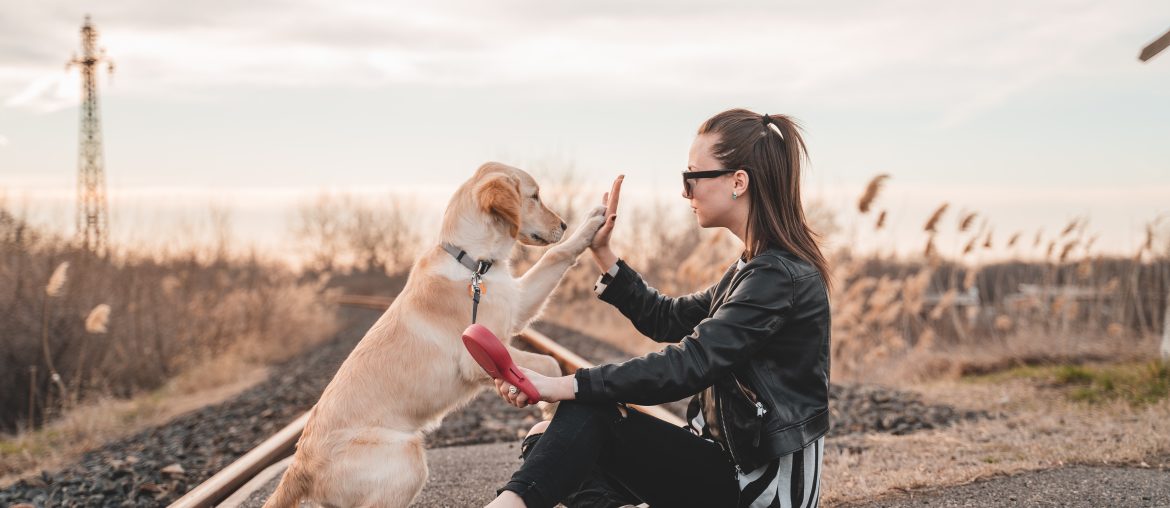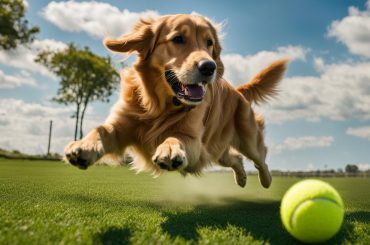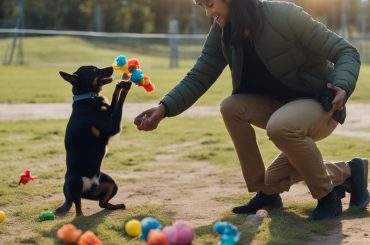Teaching an old dog new tricks is not only possible but also beneficial for their mental stimulation and overall well-being. In this ultimate guide, I will provide you with expert tips and strategies to successfully train your older dog. From understanding their physical limitations to using positive reinforcement techniques, I’ll cover everything you need to know to unleash your pet’s potential regardless of age.
Key Takeaways:
- Training an old dog is beneficial for their mental stimulation and overall well-being.
- Understanding their physical limitations is crucial for successful training.
- Positive reinforcement techniques are effective in teaching older dogs.
- Patience and consistency are key when training older dogs.
- Training sessions should be short and engaging to keep older dogs motivated.
Benefits of Training an Older Dog
Training an older dog comes with numerous benefits that contribute to their mental stimulation, behavior improvement, and overall well-being. By teaching tricks to your senior furry companion, you provide them with engaging mental exercises that help prevent cognitive decline and keep their mind sharp.
This mental stimulation is especially crucial for older dogs as it helps keep their brains active and prevents boredom, which can lead to behavioral issues. Training sessions provide an opportunity to reinforce desired behaviors, curb undesirable ones, and strengthen the bond between you and your pet.
Furthermore, teaching tricks to older dogs can be a fun and rewarding experience for both you and your furry friend. Seeing them learn and master new skills brings a sense of accomplishment and pride, while the positive reinforcement you provide during the training process boosts their confidence and encourages continued learning.
Mental Stimulation for Senior Dogs
The mental stimulation gained from training sessions can have significant benefits for senior dogs. It helps prevent cognitive decline, improves memory, and enhances problem-solving abilities. Additionally, mental exercises can reduce anxiety and boredom, leading to improved overall behavioral well-being.
Improving Behavior in Older Dogs
Training an older dog helps address behavior issues by reinforcing desired actions and discouraging unwanted behaviors. By focusing on positive reinforcement techniques and consistent training, you can correct problematic habits and encourage your dog to exhibit good behavior in various situations.
| Benefits of Training an Older Dog | Advantages of Teaching Tricks to Older Dogs | Mental Stimulation for Senior Dogs | Improving Behavior in Older Dogs |
|---|---|---|---|
| Keeps their mind sharp | Fosters mental stimulation | Prevents cognitive decline | Addresses behavior issues |
| Strengthens the bond with the owner | Boosts confidence and self-esteem | Enhances memory and problem-solving abilities | Encourages good behavior in various situations |
| Provides a sense of accomplishment | Reduces anxiety and boredom |
Assessing Your Dog’s Health and Abilities
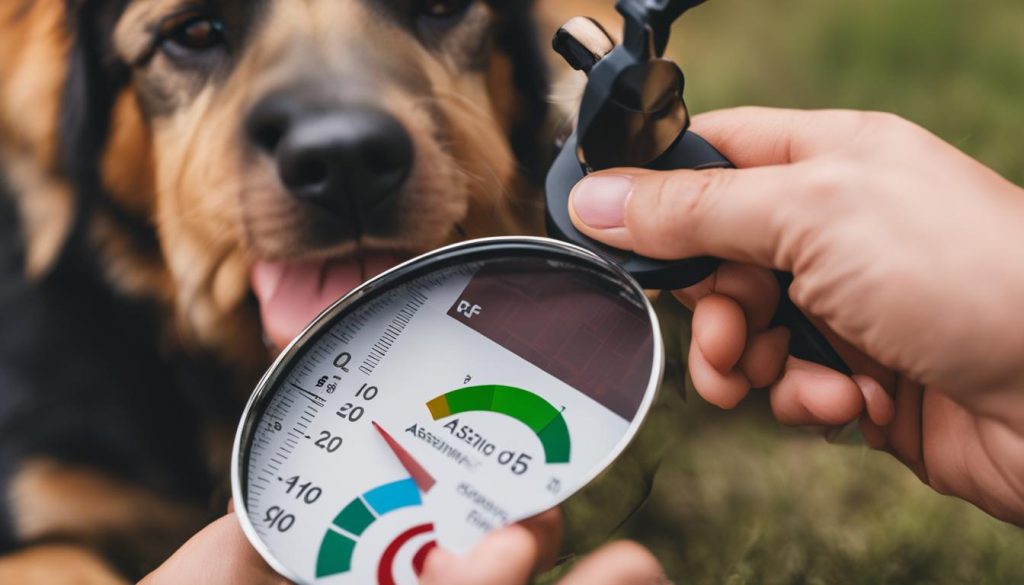
Before embarking on the training journey with your older dog, it is crucial to assess their health and physical abilities. Consulting with your veterinarian is recommended to ensure that your dog is in good health and fit for training sessions. Your vet can also identify any underlying health issues that may impact their ability to learn new tricks. Taking into consideration factors such as age, joint or mobility issues, and overall fitness, you can tailor the training program to suit their specific needs.
During the health assessment, it is essential to evaluate your dog’s physical condition thoroughly. Look for any signs of discomfort or pain, such as limping or stiffness. Understanding your dog’s limitations will help you design a training plan that avoids putting unnecessary strain on their body. By adapting exercises and activities to their capabilities, you can ensure a safe and enjoyable training experience for your senior companion.
Additionally, keep in mind that older dogs may take longer to recover and may tire more quickly than younger ones. Be mindful of their energy levels during training sessions and take breaks when necessary. This will help prevent fatigue and ensure that your dog remains engaged and focused throughout the training process.
Common Health Issues in Older Dogs
It is important to be aware of common health issues that may arise in older dogs, as they can impact their ability to participate in training activities. Some of these health issues include:
- Arthritis and joint problems
- Hearing or vision loss
- Dental issues
- Heart or respiratory conditions
- Cognitive decline
By being proactive and addressing any health concerns with your vet, you can create a training plan that takes into account these limitations and focuses on exercises and tricks that promote their overall well-being.
| Health Issue | Impact on Training |
|---|---|
| Arthritis and joint problems | May limit mobility and require low-impact exercises |
| Hearing or vision loss | May require alternative training cues or visual aids |
| Dental issues | May affect their ability to take treats, requiring alternative rewards |
| Heart or respiratory conditions | May limit stamina and require shorter training sessions |
| Cognitive decline | May require more repetition and reinforcement during training |
Assessing your dog’s health and abilities is a critical first step in training your older companion. By understanding their physical limitations and customizing the training program accordingly, you can provide them with an enriching experience that stimulates their mind and contributes to their overall well-being.
Starting with Basic Commands and Reinforcement Techniques

When training an older dog, it’s important to start with basic commands to establish a foundation of obedience. These commands, such as sit, stay, and come, are essential for your dog’s safety and well-being. By using positive reinforcement techniques, you can motivate your senior dog to learn and obey these commands.
Positive reinforcement involves rewarding your dog for exhibiting the desired behavior. This can be done through treats, praise, or affection. For example, when teaching your dog to sit, you can use a verbal cue, gently guide them into the sitting position, and reward them with a treat and praise. Repeat this process consistently and gradually reduce the use of physical guidance to encourage your dog to respond to the verbal cue alone.
It’s important to be patient and consistent in your training approach. Older dogs may take longer to learn new commands, but with persistence and positive reinforcement, they can successfully master basic obedience. Remember to keep training sessions short and engaging, focusing on quality rather than quantity. This will help prevent your dog from becoming bored or fatigued during the training process.
The Benefits of Teaching Obedience to Older Dogs
Teaching obedience to older dogs has several benefits. First, it ensures their safety by providing them with the necessary skills to respond to commands and avoid dangerous situations. For example, teaching your dog to come when called can prevent them from running into traffic or getting lost.
Additionally, obedience training strengthens the bond between you and your older dog. By working together and establishing clear communication, you can develop a deeper understanding and mutual trust. This can enhance your dog’s overall behavior and make them more enjoyable to be around.
Lastly, teaching obedience to older dogs promotes mental stimulation and prevents cognitive decline. The process of learning and responding to commands exercises their brain, keeping it active and engaged. This can help slow down age-related cognitive decline and keep your dog mentally sharp.
| Basic Commands for Older Dogs | Description |
|---|---|
| Sit | Teach your dog to sit on command, which is a versatile and essential command for various situations. |
| Stay | Train your dog to stay in one place until released, ensuring their safety and preventing them from running off. |
| Come | Teach your dog to come to you when called, which is crucial for their safety and allows them to enjoy off-leash adventures. |
| Leave it | Train your dog to ignore and not pick up or eat potentially harmful objects or substances. |
By starting with basic commands and using positive reinforcement techniques, you can lay the foundation for successful training with your older dog. Remember to be patient, consistent, and make the training sessions enjoyable for both you and your furry companion.
Tailoring Training to Your Dog’s Abilities and Limitations
When training older dogs, it’s crucial to adapt the training methods to their specific abilities and limitations. As dogs age, they may experience physical limitations such as joint stiffness or decreased mobility. To ensure a safe and effective training experience, it’s important to make adjustments accordingly.
One key aspect of tailoring training for older dogs is modifying tricks to suit their capabilities. Focus on exercises that promote joint flexibility and muscle strength, while avoiding activities that may put excessive strain on their bodies. For example, if your older dog has difficulty jumping, you can modify a trick that requires jumping by substituting it with a trick that focuses on balance or coordination.
In addition to modifying tricks, it’s essential to adjust the overall training program to accommodate any physical limitations. Choose low-impact exercises and activities that are gentle on your dog’s joints. Gradually introduce new challenges and increase difficulty levels at a pace that is comfortable for your dog. Always prioritize their safety and well-being throughout the training process.
Table: Adapted Training Exercises for Older Dogs
| Trick/Exercise | Description |
|---|---|
| Balance Board | Aids in improving your dog’s balance and core strength. Start with short sessions and gradually increase duration. |
| Gentle Fetch | Play fetch with a soft toy to minimize impact while still providing mental stimulation and exercise. |
| Target Training | Teach your dog to touch a target with their nose or paw. This low-impact exercise helps with focus and coordination. |
| Slow Stroll | Take leisurely walks to allow your older dog to explore their surroundings without putting excessive strain on their joints. |
| Puzzle Toys | Engage your dog mentally by providing puzzle toys that encourage problem-solving and cognitive stimulation. |
Remember to always listen to your dog and observe their behavior during training. If they show signs of discomfort or fatigue, it’s important to take a break or modify the exercise accordingly. By adapting the training to your dog’s abilities and limitations, you can ensure a positive and rewarding experience for both of you.
Using Positive Reinforcement and Patience
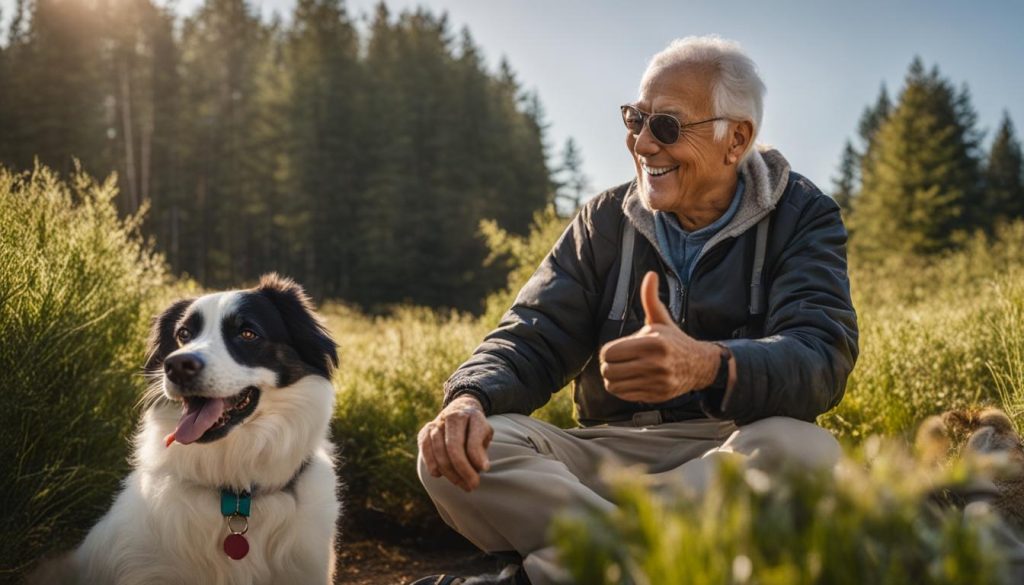
When it comes to training older dogs, positive reinforcement is a crucial technique. This rewards-based training method involves providing treats, praise, and affection to reinforce good behavior. By using positive reinforcement, you create a positive association between the desired actions and the rewards, motivating your older dog to repeat those behaviors. It’s important to remember that older dogs may require more time and repetition to learn new tricks, so patience is key.
The patient approach to training older dogs involves understanding their individual needs and limitations. Older dogs may have physical or cognitive limitations that affect their ability to learn new tricks. By recognizing and adapting to these limitations, you can tailor the training program to suit their capabilities. This may involve modifying tricks to be more accessible, using low-impact exercises, and focusing on activities that promote joint flexibility and muscle strength.
“Training an older dog requires patience, understanding, and a positive attitude. By using positive reinforcement techniques and taking into account their limitations, you can create a rewarding and enjoyable training experience for both you and your older dog.”
A rewards-based training approach is especially beneficial for senior dogs. It not only motivates them to learn new tricks but also strengthens the bond between you and your furry companion. By consistently providing positive reinforcement and being patient and understanding, you can help your older dog unlock their full potential and enjoy the process of learning new skills.
Tips for Using Positive Reinforcement and Patience:
- Always have treats or rewards handy during training sessions.
- Use verbal praise and affectionate gestures, such as petting and gentle massages, to reinforce desired behaviors.
- Be consistent in your training approach and use the same verbal cues and commands.
- Avoid punishment or negative reinforcement, as it can undermine the training process and cause anxiety or fear in your older dog.
- Understand that progress may be slower with older dogs, so be patient and celebrate small successes along the way.
By utilizing positive reinforcement and maintaining a patient approach, you can effectively train your older dog and enhance their overall well-being. Remember to tailor the training to their abilities, keep sessions engaging and enjoyable, and always promote a positive and nurturing training environment.
Maintaining Engagement and Preventing Fatigue in Senior Dogs
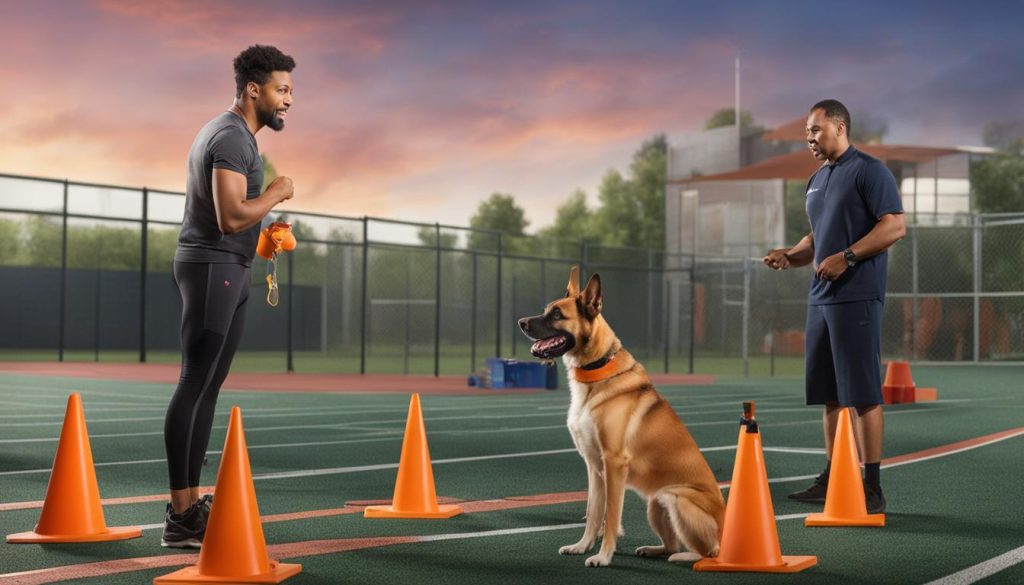
When training older dogs, it is important to keep their attention and energy levels in mind. Short, engaging training sessions are key to ensuring their success. By following a few simple strategies, you can maintain their engagement and prevent fatigue during training.
1. Keep Sessions Short and Consistent
Older dogs may have shorter attention spans and tire more easily. It is best to keep training sessions brief, typically around 10 to 15 minutes at a time. By breaking the training into shorter sessions throughout the day, you can maintain their focus and prevent them from getting overwhelmed or bored.
2. Use Interactive and Varied Exercises
Varying the exercises and incorporating interactive elements can help keep your senior dog engaged during training. Introduce new toys, obstacles, or puzzles to stimulate their curiosity and make the training sessions more enjoyable. This can prevent monotony and keep their minds active and focused on the task at hand.
3. Watch for Signs of Fatigue
It is important to be mindful of your dog’s energy levels and watch for signs of fatigue during training. Yawning, excessive licking, or dropped ears are indications that your dog may be getting tired. If you notice these signs, it’s time to take a break and let them rest. Pushing them beyond their limits can lead to frustration and hinder the training progress.
By implementing these strategies, you can keep your older dog engaged and prevent them from getting fatigued during training sessions. Remember to be patient and understanding, and always tailor the training to their abilities and limitations. With consistent and engaging training, you can help your senior dog continue to learn and thrive.
Progressing Gradually and Building on Success
When training an older dog, it’s important to take a step-by-step approach and build on small successes. By gradually increasing the difficulty level and focusing on building a strong foundation, you can help your dog develop new tricks and behaviors. The key is to celebrate each small success along the way, keeping your dog motivated and engaged throughout the training process.
Start with simple tricks that your dog is already familiar with. This will provide a sense of confidence and encourage them to continue learning. Once they have mastered the basics, gradually introduce new commands and challenges. Remember to be patient and understanding, giving your dog plenty of time to practice and absorb the information.
In addition to building on small successes, it’s important to reinforce previously learned behaviors. This will help solidify their understanding and allow them to generalize their training to different situations. For example, if your dog has learned to sit on command, practice this command in various locations and with different distractions to ensure they can perform it reliably.
To visually track your dog’s progress and document their achievements, use the table below:
| Trick or Behavior | Level of Proficiency |
|---|---|
| Sit | Excellent |
| Lie Down | Good |
| Stay | Fair |
| Shake Paw | Excellent |
| Roll Over | In Progress |
Remember that every dog learns at their own pace, so don’t rush the process. Training an older dog requires time, patience, and dedication. By progressing gradually and building on small successes, you can help your furry friend reach their full potential and enjoy the fruits of their newfound skills.
The Importance of Consistency and Dedication
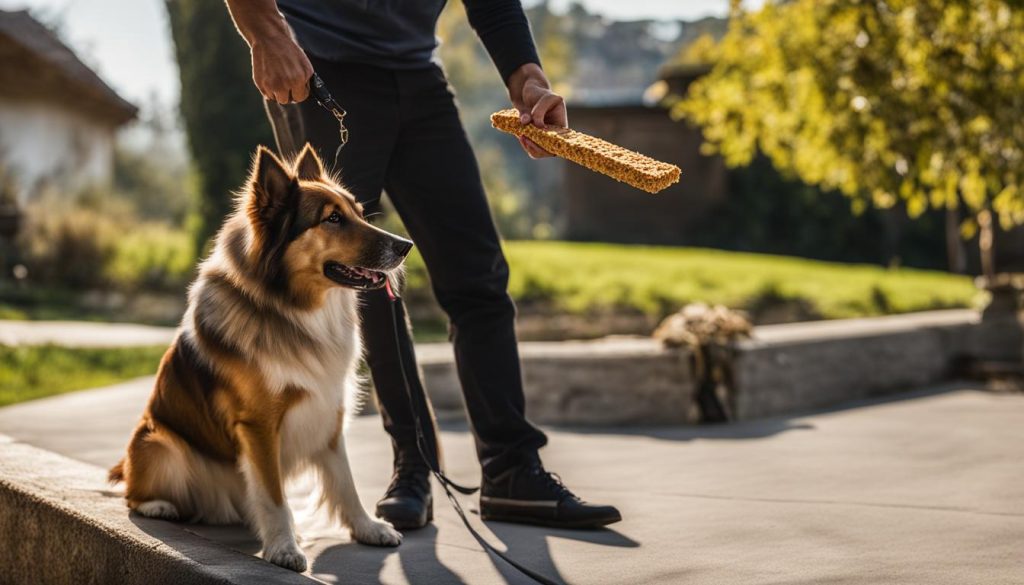
Consistency and dedication are vital when it comes to training older dogs. As with any form of learning, repetition and consistency help your dog understand and retain new commands and tricks. By using the same verbal cues consistently, you establish a clear communication system with your furry friend.
A dedicated approach is also essential in teaching old dogs new tricks. It requires time, patience, and persistence to see progress. Set aside regular training sessions to work with your dog, focusing on positive reinforcement and rewards to motivate them. Remember, older dogs may take longer to grasp new concepts, so it’s crucial to maintain a positive attitude throughout the process.
Training an older dog requires commitment. It’s a journey that involves understanding your dog’s limitations, adapting the training to their abilities, and celebrating small achievements along the way. By committing to the training process, you can build a stronger bond with your dog and unlock their untapped potential.
Tips for Consistency and Dedication in Dog Training
- Establish a consistent routine: Set aside specific times for training sessions and stick to them.
- Use consistent cues: Use the same verbal commands and cues every time you want your dog to perform a specific action.
- Practice regularly: Regular practice helps reinforce training and keeps your dog engaged.
- Be patient and positive: Older dogs may take longer to learn, so patience and a positive attitude are key.
- Focus on rewards: Use treats, praise, and affection as rewards to reinforce desired behaviors.
In training older dogs, consistency and dedication are the keys to success. With a committed approach and regular practice, you can teach your old dog new tricks and enjoy the rewarding experience of seeing them grow and learn.
Remember, each dog is unique, and training progress may vary. Tailor the training to your dog’s needs and limitations, and always prioritize their well-being. With consistent effort and dedication, you can achieve remarkable results and create a stronger bond with your beloved older dog.
Final Thoughts
To summarize, training older dogs is not only possible but also highly beneficial for their overall well-being. By following the expert tips and strategies outlined in this guide, you can achieve great success in teaching new tricks to your senior canine companion.
It is important to tailor the training to your dog’s abilities and limitations, taking into consideration their age and any physical conditions they may have. Using positive reinforcement techniques, such as treats and praise, will help motivate and reinforce desired behaviors.
Remember to be patient and consistent throughout the training process. Older dogs may require more time and repetition to learn new tricks, so maintaining a dedicated and committed approach is key.
By unleashing your pet’s untapped potential through training, you can strengthen the bond between you and your dog while providing them with mental stimulation and a sense of accomplishment. So, don’t hesitate to embark on this rewarding journey of teaching your old dog new tricks!
FAQ
Is it possible to teach an old dog new tricks?
Yes, it is possible to teach an old dog new tricks. With the right approach and techniques, older dogs can learn and benefit from mental stimulation and training.
What are the benefits of training an older dog?
Training an older dog provides mental stimulation, improves behavior, and strengthens the bond between you and your pet. It can also prevent cognitive decline and keep your dog’s mind sharp.
How do I assess my older dog’s health and abilities before training?
It’s important to consult with your vet to ensure your dog is fit for training and to identify any health issues that may affect their ability to learn new tricks. Consider their age, mobility, and joint issues when planning training sessions.
Where should I start when training an older dog?
Start by reinforcing basic commands that your older dog may already know. Use positive reinforcement techniques like treats and praise to motivate and reward their desired behavior.
How do I tailor training to my older dog’s abilities and limitations?
Make adjustments to accommodate any physical limitations your dog may have. Choose low-impact exercises, avoid excessive jumping or strenuous activities, and modify tricks to suit their capabilities.
What is the role of positive reinforcement in training older dogs?
Positive reinforcement is key when training older dogs. Reward their good behavior with treats, praise, and affection to reinforce desired actions. Avoid punishments or negative reinforcement.
How long should training sessions be for older dogs?
Older dogs may have shorter attention spans and lower energy levels. Keep training sessions brief, focusing on quality rather than quantity. Watch for signs of fatigue and adjust session length accordingly.
How should I progress in training an older dog?
Start with simple tricks and gradually increase the difficulty level as your dog becomes more proficient. Celebrate small successes along the way to keep your dog motivated and engaged.
Why is consistency and dedication important in training older dogs?
Consistency and dedication are essential in training older dogs. Establish clear rules and boundaries, use the same verbal commands consistently, dedicate regular time to training, and maintain a positive attitude throughout.
Can I conclude that training older dogs is worth the effort?
Yes, training older dogs is worth the effort. By following the tips and strategies provided in this guide, you can successfully train your older dog and enjoy the benefits of their newly acquired skills.


